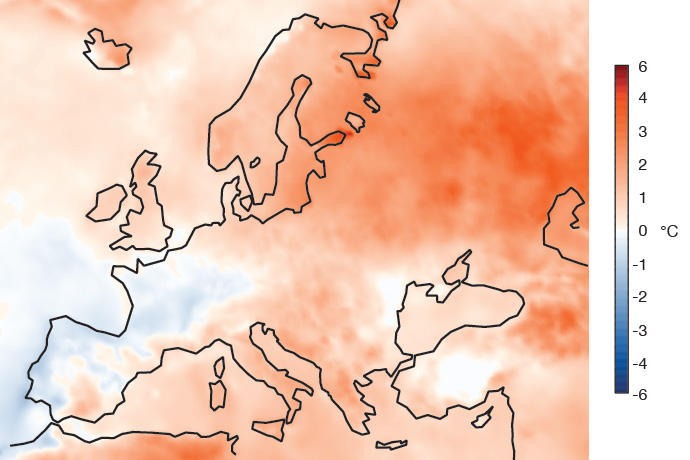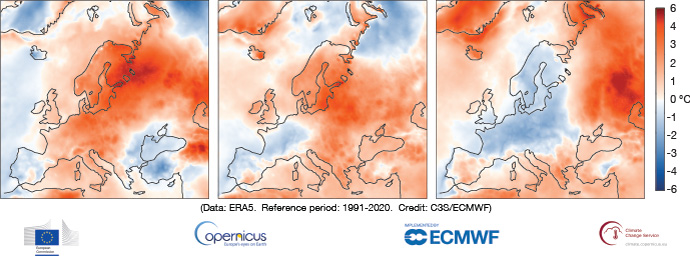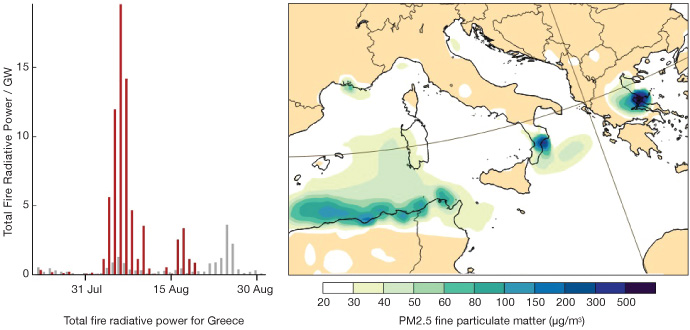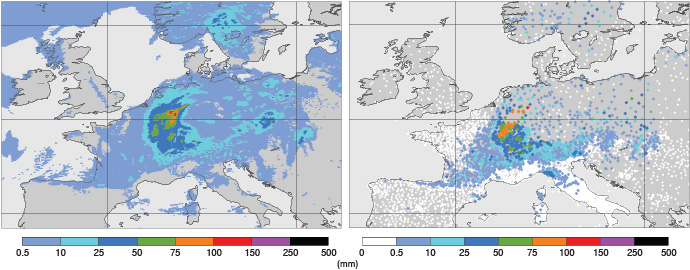

Surface air temperature anomaly for the summer in Europe from June to August (JJA) 2021 relative to the average for 1991–2020. Data source: ERA5. Credit: Copernicus Climate Change Service/ECMWF.
The European summer of 2021 stands out for great heat, which came with regional fires, but also for heavy rain, which brought devastating floods.
Here we show how ECMWF, and the EU’s Copernicus Services which we operate or contribute to, saw some of the summer’s main weather-related events.
Heat
Europe experienced its second warmest June on record this year, with temperatures 1.5°C higher than the average for 1991–2020, according to the Copernicus Climate Change Service (C3S) run by ECMWF.
It also experienced its second warmest July, with temperatures 1.4°C above the average, while August was close to the 1991–2020 average.

Surface air temperature anomaly for June, July and August 2021 (left to right) relative to the June, July and August averages for the period 1991–2020. Data source: ERA5. Credit: Copernicus Climate Change Service/ECMWF.
Overall, the period June–July–August ranks as the warmest European summer, although it is closely followed by the summers of 2010 and 2018. Particularly high temperature anomalies were recorded in the eastern part of the continent (see the plot at the top of the article).
For more information on summer temperatures as well as other variables, see the C3S climate bulletins on the C3S website.
High temperatures and fire
The Mediterranean experienced a heatwave in August, which gradually shifted from east to west. Here we show ECMWF’s Extreme Forecast Index (EFI) for 2-metre maximum temperature on 11 August, from seven days and one day before the event.

The EFI for 2-metre maximum temperature on 11 August, from 144–168 hours before (left) and 0–24 hours before (right).
The high temperatures favoured the development of regional fires. Their emissions were forecast by the Copernicus Atmosphere Monitoring Service (CAMS) operated by ECMWF.

On the left we show CAMS daily total fire radiative power for Greece in 2021 (red) compared to the maximum value previously observed between 2003 and 2020 (grey), and on the right the CAMS 12-hour fine particulate matter (PM2.5, particles with a diameter smaller than 2.5 micrometres) forecast for 12 UTC on 11 August 2021. Credit: Copernicus Atmosphere Monitoring Service/ECMWF.
More information on the situation in early August is included in an article on wildfires in the Mediterranean region on the CAMS website.
Rain and floods
A period of intense rainfall in July, especially over parts of Germany and Belgium, led to devastating floods in some areas. ECMWF high-resolution forecasts predicted the broad location and intensity of the rain three days in advance.


The charts show the predicted rainfall in the 24-hour period starting on 14 July 2021 at 06 UTC, 78 hours in advance (top) and 6 hours in advance (bottom left), as well as recorded amounts in the same period (bottom right).
The rain led to extensive flooding, in particular in parts of Germany and Belgium.

The map shows the European Flood Awareness System (EFAS) 10-day flood forecast issued on 12 July 2021 at 00 UTC. The red squares are points of interest (‘reporting points’) on the river network where the flood signal was predicted to exceed the 1 in 5 year flood return period threshold. The river discharge hydrograph (inset) is shown for the River Meuse near Visé in Belgium (drainage area of 20,825 km2). Right-click on the image and choose ‘Open Image in New Tab’ to view a bigger version.
ECMWF is the computational centre for the hydrological forecasting activities of the EU’s Copernicus Emergency Management Service (CEMS). More details on the work of this service can be found on the CEMS website.
